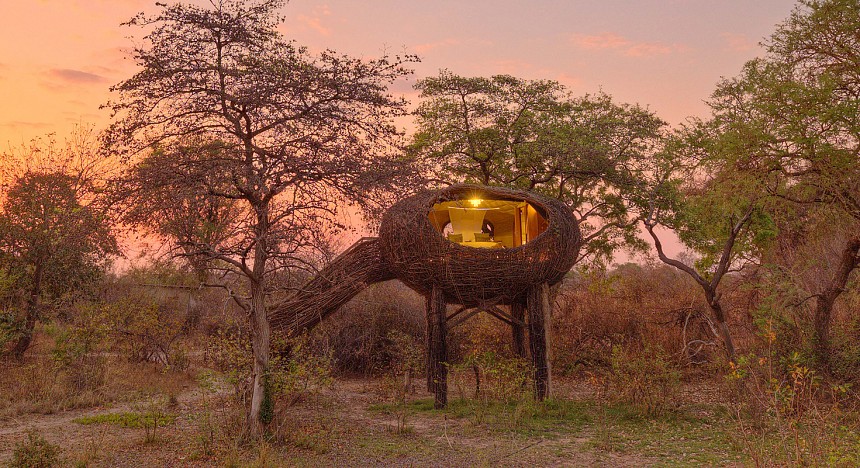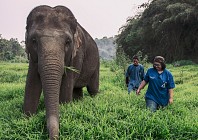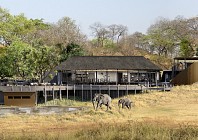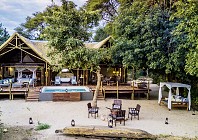A ninth pair of ears, eyes and nostrils appear, accompanied by a wheezing honk and colossal splash, reminding me that we’re very much in hippo territory. This particular hippo highway – where these non-swimming 3,000-pounder creatures slow-motion gallop across the riverbed – is the Kafue River. It’s the lifeline of its namesake national park, located in Zambia’s western region. Despite being dubbed the planet’s ‘second largest wildlife sanctuary,’ Kafue remains relatively under-the-radar as safari destinations go.

Nestled right in its heart is Ila: a luxury waterfront lodge reached via a four-hour overland transfer from Zambia’s capital of Lusaka, where I touched down earlier this morning for part one of my African adventure, arranged by tailor-made trip specialists Audley Travel. Very literally off-grid, Ila is the flagship property of Green Safaris, who launched Zambia’s first electric game drive vehicle (the ‘eLandy’) in 2012. Powered by the eco-centric outfit’s own solar farm, its fleet of four electric 4x4s aren’t the only thing to be charged by the South African sun.

Silently skimming across Kafue’s silken waters is the lodge’s sleek 12-seater e-boat, that’s also home to a breeding pair of wire tailed swallows, who entertain me with their endless acrobatic displays. The 90-minute-long private cruise plays out to a sunset symphony of grunting hippo pods, grey “go away” birds (so nicknamed for their nasally ‘g’way’ call) and trumpeting bankside elephants. “Elephants have a good memory. They don’t forget easily. They still remember how and who they lost their brothers and sisters to,” reveals Fraser ‘Shi’ Shibomba, my wildlife guide. Before transforming into the predator-rich paradise safari-goers see today, Kafue was blighted by half a century of poaching.

The fading light signals our return to terra firma, where I wash away the dust of the day with a solar-heated shower in the comforts of my mod African-styled accommodation. Boasting an extra-length bed and brass vanities, it’s one of 10 tents that are strung along a half-mile stretch of river.

Fireside chats, buffet-style breakfasts and cooling pool dips all unfold in the central boma, that’s set to unveil a brand-new look in January after an extensive remodel. This is also where guests can devour three-course dinners; cooked with biogas generated by fermented waste, and featuring produce harvested from Ila’s community-run farm. Under star-studded skies I tuck into a vegan ravioli starter, followed by grilled beef fillet and a sticky date pudding that demands seconds.

The next morning, it’s not the steaming hot chocolate delivered to my canvas door that wakes me up, rather the splish-sploshing of a hippo right under my stilted terrace! I join four other guests in exploring our mercifully flat-as-a-pancake backyard on foot, accompanied by an armed ranger and Shi. Fluent in the language of the bush, within minutes he’s pointing out the holes of anteaters and honey badgers (a fearless animal known to confront lions) and reading the day’s “scat news” as we snake through a landscape dotted with sausage trees and termite mounds. It’s no coincidence that the founder of Kafue National Park, Norman Carr, also pioneered Africa’s original ‘Walking Safari,’ designed to uncover the smaller details of the bush more than often missed on a classic game drive.

I’m relieved that those heart-thumping predator encounters are reserved for the jeep at Ila’s smaller sister camp, Chisa, cast 85 miles north in the Busanga Plains. The short but scenic propeller plane ride here reveals how Kafue’s remote northern wilderness has come to earn its “Okavango-Delta-meets-the-Serengeti” nickname. A patchwork of golden grasses, lily-covered lagoons and fertile dambos (shallow seasonal wetlands), Busanga’s endangered African Hunting dog and pangolins live alongside some 20 species of antelope and big cats like leopards and magnificent black-maned lions.

Nestled on its own tree-lined islet, Chisa is only accessible by canoe until the region’s flood waters retreat in May. Despite opening in the throes of the pandemic, the entirely solar-powered unfenced camp still managed to recover 100 per cent of its carbon emissions in 2021.

With our water bottles filled with Chisa’s own borehole-pumped purified water, we set out silently across the savannah in an electric land cruiser. “Water is life here,” guide Isaac Kapangila whispers, as we watch an endangered wattled crane contort its long neck whilst African openbills scoff water snails between the papyrus reeds. A veritable birders paradise, rosy-throated longclaws, jacanas, gross ibises and saddle-billed storks are just a handful of the 500 avian species that inhabit Busanga Plains. Most surreal is marvelling at a type of water-loving antelope called red lechwe, that navigate the swampy ground by spreading out their hooves like 4x4s. “This is a food garden for lions!” Kapangila exclaims, referring to the juvenile lechwes, which awkwardly wade knee-high through the wetlands. Even Busanga’s iconic black-maned lions have adapted to the life semi-aquatic, leaping across channels when necessary.

On the second game drive of the day, we close in on ‘Killing Machine’: a six-year-old lioness whose striking beauty and scarless-face defies the ruthless hunter’s nefarious name. Observing her hiding in high grasses with her three cubs is an experience made even more magical by there being no sight nor sound of another vehicle. Everything from the shrill whistle of a hamerkop bird to an elephant’s footfall is amplified. With no diesel engine noise to distract us from the bush theatre, the only growl you’re likely to hear is from a territorial male lion, or your own stomach.

Our own hungry pack circle back to camp for a lantern-lit communal-style dinner at Chisa’s sandy-floored boma. Decorated in soothing shades of taupe and outfitted with sinkable sofas, textile wall art, oversized vases and coffee table tomes, it’s the epitome of elegant safari chic.

Escorted by a torchlit team member, I retreat to my stylish stilted perch: a four-metre-high, human-sized bird’s nest that’s hewn from branches and made by basket-weaving locals. Inspired by chattering African Weaver nests (known as “chisa” in the local Nyanja language), the canvas-lined elliptical treehouse’s pièce de résistance has to be the observation deck, which affords a literal bird’s eye view of Busanga’s never-ending flood plains.

Swapping one watery wonderland for another, the third and final chapter of my silent safari delivers me to a sweeping bend of the mighty Zambezi River in the country’s deep south. Set right on the shoreline is award-winning eco lodge, Tongabezi, which was added to Green Safari’s expanding portfolio three years ago. Vaunting 250 metres of private river frontage that’s bookended by two pools, it plants guests seven miles upstream from one of the world’s seven natural wonders. Forming a natural border between Zambia and Zimbabwe, a visit to Victoria Falls is one of a raft of excursions offered as part of the property’s all-inclusive stay.

I waste no time in launching myself into yet another low-carbon adventure, this time departing from Tongabezi’s private river jetty. “The Zambezi zig-zags. It’s never straight,” my guide Douglas Mwaanga reveals whilst navigating along its upstream course, where there’s said to be one crocodile lurking every 10 metres! No ordinary river boat, our vessel is an electric dhow. Believed to be the only one of its kind in the world, it’s hewn from Zambian mukwa wood and runs on renewable hydroelectricity from the region’s Batoka Gorge power station. A genuinely 360-degree wildlife experience, a flock of Egyptian Geese fly in formation above our heads, whilst baboons browse alongside impala on the river’s west bank which lies in neighbouring Zimbabwe. With no noisy motor to blame for a border-crossing Nile crocodile stirring from his siesta, we continue our guilt-free game viewing until the fiery orange sky turns inky blue.


Virtually camouflaged from the water thanks to a thick grove of African ebony trees, Tongabezi’s five cottages contour the river, whilst its six themed houses – which include a tri-levelled treehouse – climb up its greened banks. The lodge’s main area stretches across a two-tiered deck that’s scattered with dining tables and features a semi-circular fire pit jutting right out over the Zambezi. Stocked with sustainably-sourced logs from Zambia’s Copperbelt forests, it’s the perfect place to sup on a pre-prandial drink, if your personal valet hasn’t sprung a surprise on you that is! I retreat to my aptly-named ‘Bird House’ – the loftiest of all Tongabezi’s uniquely-styled stone-thatched houses – to find bubbles filling both my sweeping terrace’s clawfoot bath and ice bucket.

Slowly soaking to the soundtrack of honking hippos certainly makes for a more interesting bathing routine. Whilst Tongabezi can’t compete with Ila and Chisa’s remote wilderness settings, it can claim a surprising array of resident wildlife. Vervet monkeys sometimes scamper in the trees, Henry the Hippo keeps the river cottages’ lawns trim at night, whilst a trio of skittish bushbuck (escapees from a nearby park) roam the grounds. My fifth and final game drive of the trip-tych takes me to nearby Mosi-oa-Tunya National Park which translates as ‘The smoke that Thunders’: Victoria Falls’ pre-colonial name. A highlight of visiting here is walking with 10 (relocated) white rhinos, supervised round-the-clock by rifle-wielding rangers. Declared extinct in Zambia in 1998 after decades of poaching, the 25-square-mile national park is giving these charismatic members of ‘Africa’s Big Five’ a second chance.

What wildlife-rich Mosi-oa-Tunya lacks in big cats, it more than makes up for with sightings of buffalo, warthog, zebra and birds like red-billed hornbills and marabou storks, all of which I see in the space of three thrilling hours. Some 300 elephants also reside here thanks to the park’s mopane trees; a favourite food that we watch a 50-strong breeding herd eagerly munch on before we depart for Mukuni village. A tour of its organic farm – which provisions the hotel with vegetables like eggplant and green beans – is one of Tongabezi’s more community-focused excursions. “The village chief surrendered 75 acres of land [for this project],” says farm manager Bernard Muloshi, as he guides me around the site that is irrigated by a borehole and ringed by solar-powered electric fences. Muloshi explains how the land is fertilised fortnightly with the help of 200 cows grazing in mobile cattle pens.

I get to enjoy some of the fruits of the Mukuni community’s labour (along with herbs harvested from Tongabezi’s own onsite garden), whilst picnicking on the Zambezi River later that afternoon. As the boat pulls up to a shaded sandbar known as “The No Man’s Land of the Zambezi,” I arrive to find a lunchtime spread set up beneath the boughs of an ebony tree. With Mwaanga keeping a watchful eye on any uninvited crocs, I can sit back, relax and drink in bi-country views of Zambia and Zimbabwe.

On the 10-minute e-dhow ride back to Tongabezi, I’m treated to one final call of the wild: the waterfall-like song of a coppery-tailed coucal, one that’s made all the more melodic and memorable by our own muted presence…

STAY:
A seven-night tailor-made trip to Zambia with Audley Travel costs from $5,868 per person (based on two travelling), staying at Ila Lodge and the Chisa Busanga nests (for two nights each), followed by three nights at Tongabezi










